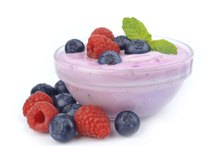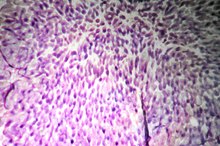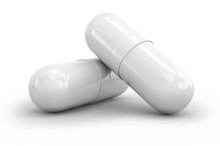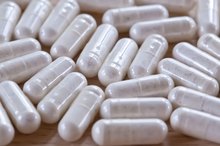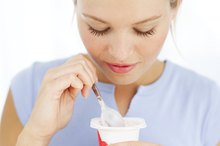What does fact checked mean?
At Healthfully, we strive to deliver objective content that is accurate and up-to-date. Our team periodically reviews articles in order to ensure content quality. The sources cited below consist of evidence from peer-reviewed journals, prominent medical organizations, academic associations, and government data.
- National Center for Complementary and Alternative Medicine: An Introduction to Probiotics
- American Society of Microbiology: In Vitro and In Vivo Survival and Transit Tolerance of Potentially Probiotic Strains Carried by Artichokes in the Gastrointestinal Tract
- American Society of Microbiology: In Vitro and In Vivo Survival and Transit Tolerance of Potentially Probiotic Strains Carried by Artichokes in the Gastrointestinal Tract
The information contained on this site is for informational purposes only, and should not be used as a substitute for the advice of a professional health care provider. Please check with the appropriate physician regarding health questions and concerns. Although we strive to deliver accurate and up-to-date information, no guarantee to that effect is made.
The Effect of Sugar on Probiotics in Yogurt
Sugar is used as a preservative in many foods. Probiotics, whether naturally occurring or added to foods, are affected by high-sugar environments. Certain probiotic strains have a natural acid-bile tolerance, giving these bacteria the ability to survive digestion in the intestines. Probiotics do not affect levels of the natural bacteria present in the gut.
Probiotics
The United Nation's Food and Agricultural Organization and the World Health Organization define probiotics as "live organisms, which, when administered in adequate amounts, confer a health benefit on the host." Intestinal flora, or "friendly bacteria," occur naturally in the human gut. Two examples, lactobacilli and bifidobacteria, found in the human intestines, are commonly used as additives in yogurt and other foods and supplements, reports Abbot Nutrition. 'Live cultures' refers to bacteria associated with foods, such as those present in fermented milk, the original source of yogurt.
- The United Nation's Food and Agricultural Organization and the World Health Organization define probiotics as "live organisms, which, when administered in adequate amounts, confer a health benefit on the host."
- Two examples, lactobacilli and bifidobacteria, found in the human intestines, are commonly used as additives in yogurt and other foods and supplements, reports Abbot Nutrition. '
Sugar's Effect on Digestion
Side Effects of FOS in Probiotics
Learn More
Sugars present in certain yogurt products and other probiotic-containing foods apparently do not interfere with the digestive processes of good bacteria in lower parts of the small intestine, according to USProbiotics.org. The organization, however, goes on to say that studies comparing identical probiotic foods with and without sugars have not been conducted.
Sugar's Effect on Cells
Food preservation utilizes concepts based on bacterial cell breakdown under high-sugar or high-salt conditions, reports the University of Missouri. An environment rich in sugar or salt draws water from cells, causing the cell walls to break down and eventually leading to cell death. The food industry has maintained a balance between the amount of sugar needed to preserve foods and the viability of probiotics in foods.
- Food preservation utilizes concepts based on bacterial cell breakdown under high-sugar or high-salt conditions, reports the University of Missouri.
- The food industry has maintained a balance between the amount of sugar needed to preserve foods and the viability of probiotics in foods.
Sugar Enhances Probiotic Digestion
Yogurt & Fatty Liver Disease
Learn More
The American Society of Microbiology reports that the ability of certain probiotic strains to survive passage through the intestinal tract is due to the organisms' acid and bile tolerance 3. This survival ability can be enhanced by the addition of sugars during food production that are easily metabolized in the human gut. The Society recommends that probiotics be regularly ingested.
- The American Society of Microbiology reports that the ability of certain probiotic strains to survive passage through the intestinal tract is due to the organisms' acid and bile tolerance 3.
- This survival ability can be enhanced by the addition of sugars during food production that are easily metabolized in the human gut.
Need to Replenish Probiotics
The University of Reading reports that milk protein, lactose and other sugars influence the survival of probiotics in the gut. The University goes on to note that varying pH environments throughout the digestive system influence different strains of probiotics in different ways. Some strains survive passage through the stomach while others survive the rest of their course through the digestive tract. Adding multiple strains of probiotics to food products guarantees that some of the probiotics survive the entire digestive process. Probiotics make insignificant changes in the level of intestinal flora, according to the University. Current research in the food industry is directed at finding foods, aside from dairy products, that will be suitable for addition of probiotics.
- The University of Reading reports that milk protein, lactose and other sugars influence the survival of probiotics in the gut.
- Adding multiple strains of probiotics to food products guarantees that some of the probiotics survive the entire digestive process.
Related Articles
References
- National Center for Complementary and Alternative Medicine: An Introduction to Probiotics
- Abbot Nutrition: Prebiotics Education
- American Society of Microbiology: In Vitro and In Vivo Survival and Transit Tolerance of Potentially Probiotic Strains Carried by Artichokes in the Gastrointestinal Tract
- Shi LH, Balakrishnan K, Thiagarajah K, Mohd Ismail NI, Yin OS. Beneficial Properties of Probiotics. Trop Life Sci Res. 2016;27(2):73–90. doi:10.21315/tlsr2016.27.2.6
- What are probiotics and can they aid GI health? American Gastroenterological Association.
- Probiotics. Fact Sheet for Health Professionals. National Institutes of Health. Office of Dietary Supplements. June 26, 2019
- Su GL, Ko CW, Bercik P, et al. AGA clinical practice guidelines on the role of probiotics in the management of gastrointestinal disorders. Gastroenterology. 2020;159(2):697-705. doi:10.1053/j.gastro.2020.05.059
- American Gastroenterological Association. Choosing the right probiotics.
- National Institutes of Health. National Center for Complimentary and Integrative Health. Probiotics: What you need to know. . August 2019
- NIH National Center for Complementary and Alternative Medicine (NCCAM). Oral probiotics: An introduction.
- Szajewska H, Konarska Z, Kolodziej M. Probiotic bacterial and fungal strains: claims with evidence. Digestive Diseases. 2016;34(3):251-259. doi:10.1159/000443359
Writer Bio
Karen Klefstad began her writing career in 2010. She writes health and travel articles for various online publications. Klefstad is a radiation therapist and holds a Master of Science in clinical and administrative gerontology from National-Louis University.

